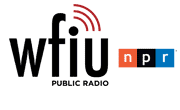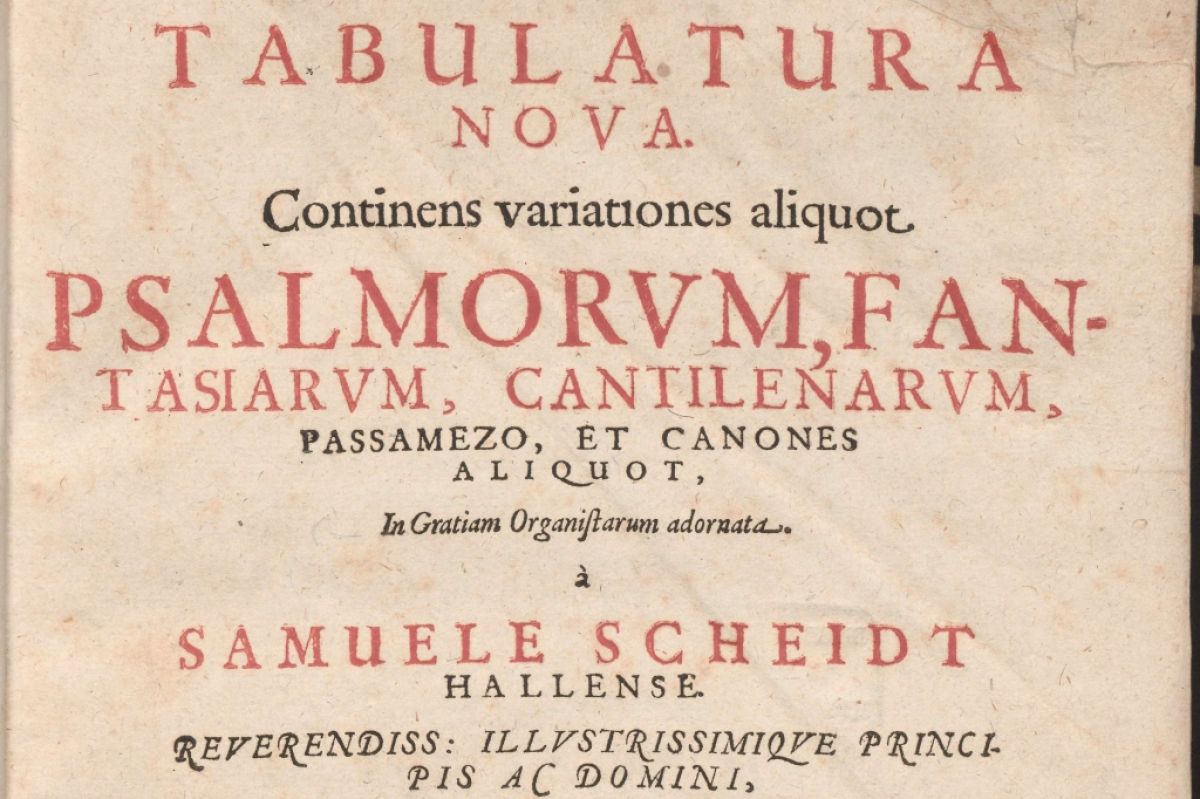[Theme music begins]
Welcome to Harmonia … I’m Angela Mariani. This hour, we celebrate the 400th anniversary of the Tabulatura Nova, a pivotal collection of keyboard music by Samuel Scheidt published in 1624. The Tabulatura Nova contains 3 volumes of sacred and secular music that can be played on a variety of keyboard instruments. The title means “new tablature,” and is an allusion to the notation system Scheidt used to set his music. Previously, keyboard music in Germany was written with letter tablature. The Tabulatura Nova used an open score format on staff notation. Then, on our featured recording, ensemble Vox Luminis brings us a collection of Renaissance vocal music.
[Theme music fades at :59]
Samuel Scheidt Complete Organ Music Vol. 7
Michael Dierks
Fagott Records | F-3909-6 (2012)
Samuel Scheidt
Tr. 22 Echo no. 1 (4:52)
Samuel Scheidt’s “Echo for 2 manuals.” We heard organist Michael Dierks switch between a loud manual and a soft manual after every phrase, / sometimes in quick succession, / creating an echo effect.
(Begin music bed:Samuel Scheidt Complete Organ Music Vol. 7, Michael Dierks, Tr. 23 Echo no. 2)
Samuel Scheidt was born in 1587 in Halle, a city in north-eastern Germany. In 1608, he travelled to Amsterdam to study with Jan Sweelinck, one of the most prominent organists in Europe known not only for his playing, but also for his compositions and teaching. Sweelinck’s students established the north-German organ tradition and included organists like Scheidt, Jacob Praetorius, and Heinrich Scheidemann. A line can be drawn from this group of organists to the organ music of Johann Sebastian Bach almost 100 years later.
In 1609, Scheidt returned to Halle and began working as the Court Organist. His duties included playing organ for services at the chapel as well as providing secular keyboard music for the court. The Tabulatura Nova grew out of the necessities of his work in Halle. Through these three volumes of keyboard music, Scheidt collected all genres of keyboard music in one publication, providing examples of both sacred and secular music that made the Tabulatura Nova a critical document for any working musician.
[fade music bed during the next paragraph]
The first two volumes include both sacred and secular music. Most of the sacred pieces are based on Lutheran hymn tunes and feature multiple variations, showcasing all the different ways an organist could improvise on a theme. The secular pieces include variations on popular songs and several dances. The third volume only includes sacred music; specifically, only the parts of the liturgy that an organist was expected to play.
We’ll listen to pieces from each volume this hour, beginning in the first volume with a variation set on the tune “Vater unser im Himmelreich” – this was a hymn setting of the Lord’s Prayer. Scheidt’s contains 9 variations, one for each verse of the hymn. On this recording, we’ll hear the first four, and then the final variation.
Samuel Scheidt: Tabulatura Nova (Volume 1)
Bernard Lagacé
Calliope | CAL4746 (1980)
Samuel Scheidt
Tr. 4 Vater unser im Himmelreich, SSWV 104 (10:29)
A set of chorale variations on “Vater unser im Himmelreich,” from the first volume of Samuel Scheidt’s publication, Tabulatura Nova, played by the legendary organist Bernard Lagacé. [In this recording, Lagacé played the first through fourth variations, followed by the ninth and final variation.]
Not all pieces in the first volume were variation sets, though. Scheidt included three sprawling Fantasias, the last of which is a fantasia on the tune “Ich ruffe zu dir Herr Jesu Christ.” These pieces are highly improvisatory in nature, treating each phrase of the chorale in a different contrapuntal style. We’ll hear a lively performance of this Fantasia performed by German organist Franz Raml.
Tabulatura Nova I
Franz Raml
MDG | 614 115-2 (2003)
Samuel Scheidt
Disc 2 Tr. 8 Fantasia super “Ich ruffe zu dir Herr Jesu Christ” (6:27)
Franz Raml played Samuel Scheidt’s Fantasia on the tune “Ich ruffe zu dir Herr Jesu Christ,” from the first volume of the Tabulatura Nova.
You’re listening to Harmonia . . . I’m Angela Mariani.
(1:00) Mid Break Music Bed:
Samuel Scheidt Complete Organ Music Vol. 7
Michael Dierks
Fagott Records | F-3909-6 (2012)
Samuel Scheidt
Tr. 23 Echo no. 2 (2:43)
Welcome back. This hour, we’re exploring the wealth of 17th-century keyboard music included in Samuel Scheidt’s Tabulatura Nova. So far, we’ve explored pieces from the first volume. We turn now to the third volume, which contains liturgical repertoire for the Lutheran Mass and the Vespers service, giving the organists all the tools they needed to fulfill their duties in a church service.
During a Lutheran Mass in the 17th century, the organist would often play “in alternatum ” with the choir, meaning the organ would play the first verse, the choir would sing the second verse, the organ would play the third verse, the choir would sing the fourth verse, and so on. The Magnificat settings in the Tabulatura Nova only include the verses that an organist would have to play, meaning, the odd numbered verses. Today, Scheidt’s Magnificat settings are played at recitals, but in the 17th century, these pieces would rarely, if ever, have been played outside of a church service, mostly because they are technically only half of the Magnificat. [We will hear Scheidt’s setting of the Magnificat in “primi toni,” which means that its melody is based on a chant based on the scale known as the first mode, or tone.
Samuel Scheidt: Tabulatura Nova, Messe pour orgue
Bernard Lagace
Calliope | CAL4747 (1981)
Samuel Scheidt
Trs. 3 and 4 Gloria and Credo (this is actually the Magnificat 1 toni) (8:25)
Samuel Scheidt’s setting of the Magnificat in first mode, or tone, from the Tabulatura Nova. This setting contains only what an organist would be expected to play in the 17th century, which would have been the odd numbered verses. Bernard Lagacé performed on the organ at the Cathedral of St. Martin or San Martin, in Colmar, France.
In the third volume of the Tabulatura Nova, Scheidt provided one example of the Credo, a statement of faith recited as part of every Lutheran Mass. For this setting, Scheidt puts put the tune of the Credo in the lowest voice of the organ with long notes. The upper voices contain florid figuration alternated with moments of strict counterpoint.
Samuel Scheidt: Tabulatura Nova, Messe pour orgue
Bernard Lagace
Calliope | CAL4747 (1981)
Samuel Scheidt
Tr. 6 Magnificat 1 Toni (this is actually the Credo in unum Deum) (3:50)
Bernard Lagacé played the setting of the Credo from the third volume of Scheidt’s Tabulatura Nova.
Scheidt ended the final volume of the Tabulatura Nova with two pieces for full organ that use double pedal, meaning the organist has to hold two notes at the same time with their feet. These were examples of how to end a church service in Halle and showcase the virtuosity of Scheidt’s organ technique. The last piece of the collection is a 6-voice setting of the “Benedicamus.”
Samuel Scheidt Complete Organ Music Vol. 5
Christoph Lehmann
Fagott Records | F-3909-4 (2011)
Samuel Scheidt
Tr. 53 Benedicamus Domino, SSWV 158 (1:33)
Christoph Lehmann played the final piece of Samuel Scheidt’s Tabulatura Nova: the “Benedicamus” for double pedal. This piece, or an improvisation like it, would end a 17th-century church service in Halle, Germany.
You’re listening to Harmonia . . . I’m Angela Mariani.
Our featured recording this hour is the album A Renaissance Collection released by on the Ricercar label in 2020. It features the vocal ensemble Vox Luminis performing lesser-known 16th- and 17th-century choral works from all regions of western Europe, from the Renaissance and a bit beyond. We’ll hear three pieces from the recording: First, the motet “Deus miseratur nostri” by Danish composer Mogens Pedersøn , who traveled widely around Europe and studied with Giovanni Gabrieli. Second, the chorale “Mein himmlischer Vater” by German composer Caspar Othmayr. And third, “Ah Robin” by the English composer Robert Fayrfax, who served under both Kings Henry the VII and VIII.
A Renaissance Collection
Vox Luminis
Ricercar | RIC155 (2020)
Tr. 19 Mogens Pedersøn: Deus misereatur nostri (5:17)
Tr. 17 Caspar Othmayr: Mein himmlischer Vater (5:06)
Tr. 12 Robert Fayrfax: Ah Robin (2:08)
From our featured release, A Renaissance Collection – Vox Luminis performed three choral works from the Renaissance: first, the motet “Deus misereatur nostri” by Danish composer Mogens Pedersøn; second, the chorale “Mein himmlischer Vater” by Caspar Othmayr; and finally, the English song “Ah Robin” by Robert Fayrfax.
[Fade in theme music]
Harmonia is a production of WFIU and part of the educational mission of Indiana University.
Support comes from Early Music America: a national organization that advocates and supports the historical performance of music of the past, the community of artists who create it, and the listeners whose lives are enriched by it. On the web at EarlyMusicAmerica-dot-org.
Additional resources come from the William and Gayle Cook Music Library at the Indiana University Jacobs School of Music.
We welcome your thoughts about any part of this program, or about early music in general. Contact us at harmonia early music dot org. You can follow us on Facebook by searching for Harmonia Early Music.
The writer for this edition of Harmonia is Travis Whaley.
Thanks to our studio engineer Michael Paskash, and our production team: LuAnn Johnson, Aaron Cain, and John Bailey. I’m Angela Mariani, inviting you to join us again for the next edition of Harmonia.
[Theme music concludes]










